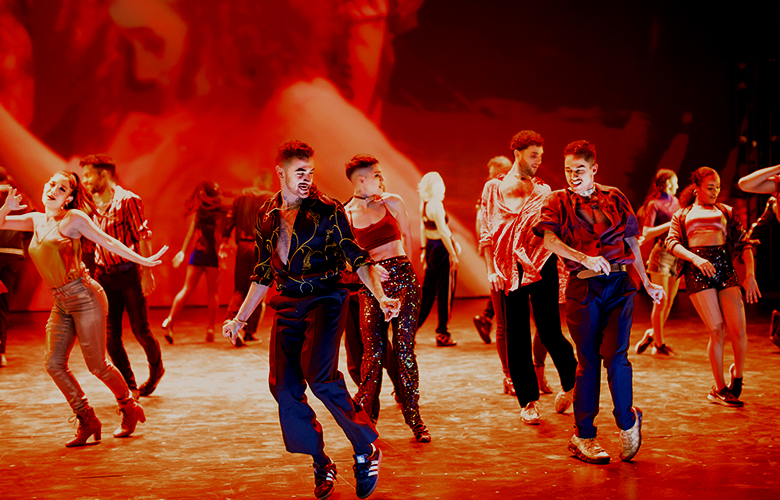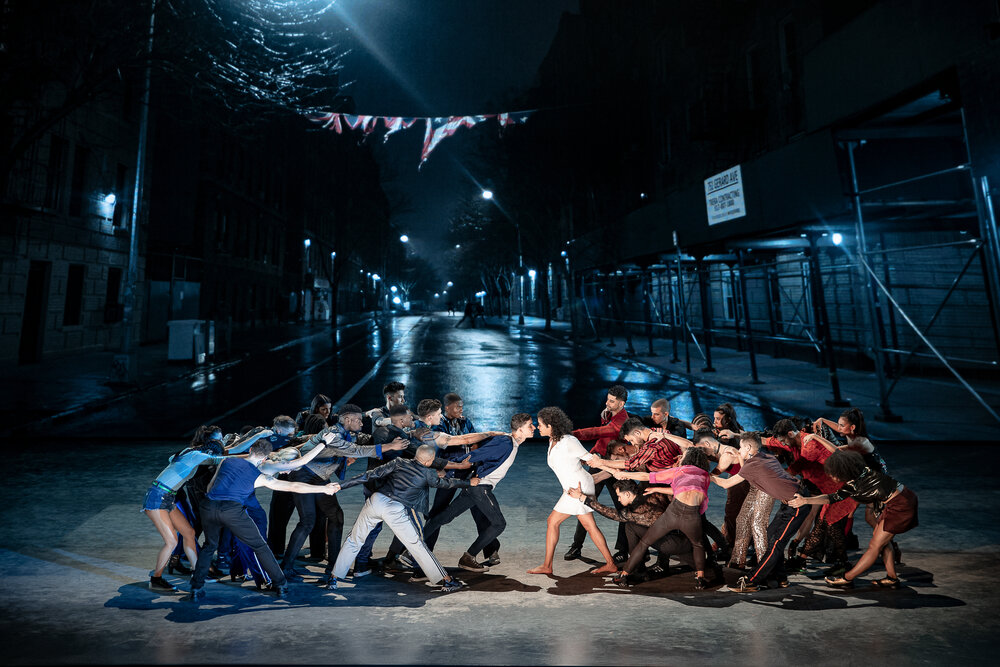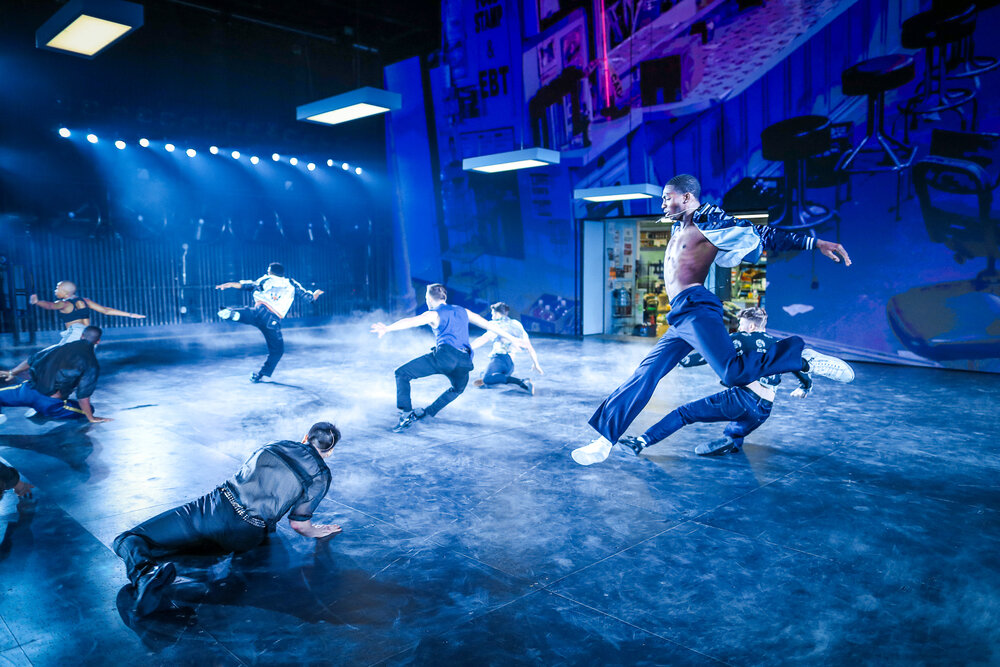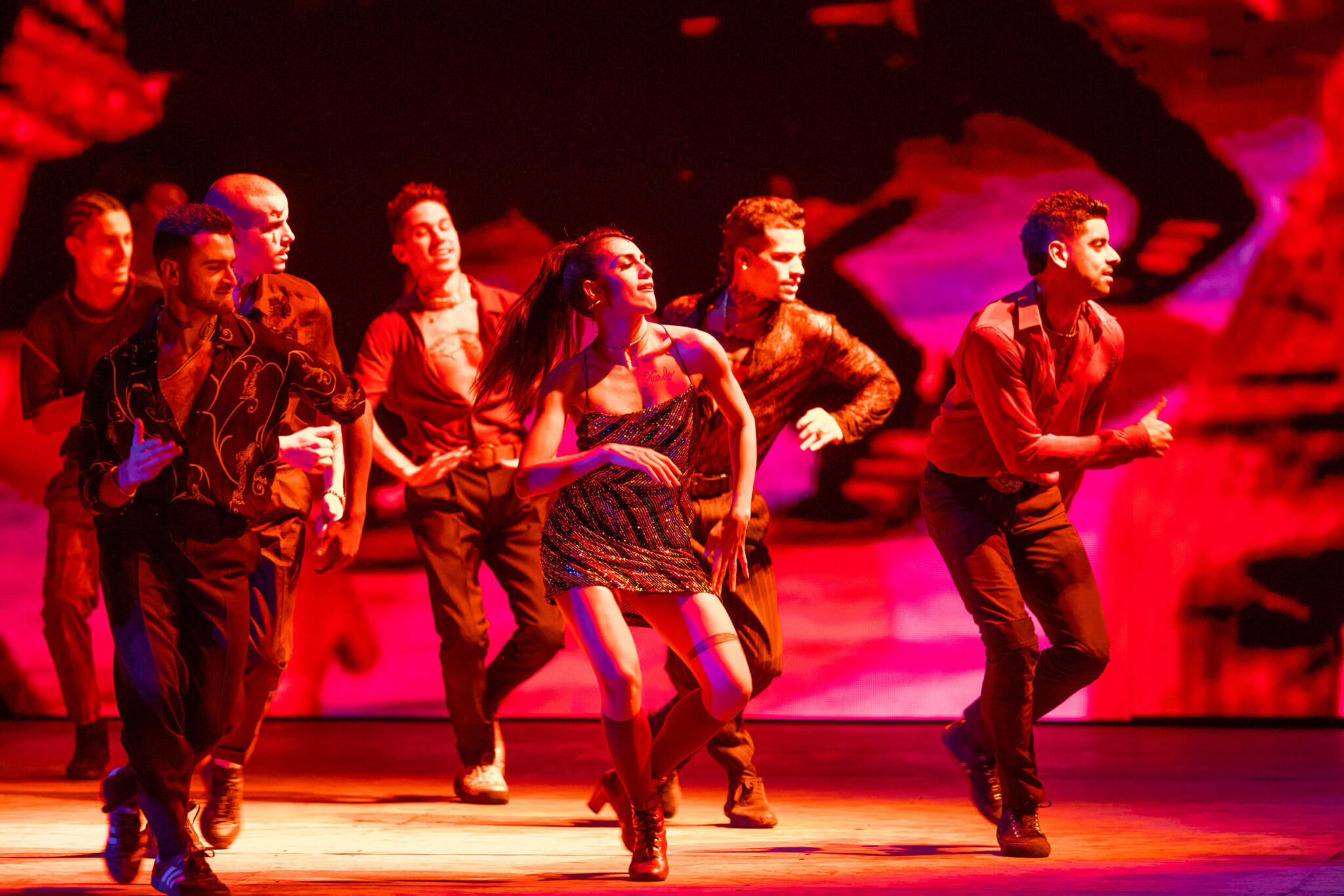
There are two camps of thought about the new West Side Story revival on Broadway: “it’s remarkable” and “it’s not for me.” I believe the truth lies somewhere in the middle. While not perfect, there is much to be lauded in the Ivo van Hove-helmed production that opened tonight at New York’s Broadway Theatre.
In the opening strains of Leonard Bernstein’s infamous overture, it is clear that this West Side Story will be different from other Mainstream outings. Gone are the iconic Jerome Robbins battements in second with arms reaching toward the sky. Instead we see a line-up of tattoo-covered men staring down unseen opponents from the proscenium’s edge. Behind them, live-streamed close-ups of their faces are projected on the entirety of the theatre’s back wall.
Rather than watching TV with a laptop open or viewing a music concert through the screen of an iPhone, the dual-viewing experience allows audiences to watch the show as both film and live performance.

It must be noted that the quality of these filmed sequences has not been seen before in a Broadway musical. While video projections have become the standard in Broadway scenic design, the filmed elements in this production have cinema-quality clarity. This is no doubt thanks to the show’s large video team, led by designer Luke Halls, director Quinn Matthews and a team of video producers and camera operators.
This dual experience allows for each scene to be optimally staged. Those in Doc’s Drugstore and the Sweatshop are filmed as they are performed far upstage, making the experience akin to watching a movie. In larger choreographic pieces (like Dance at the Gym and America), the projections work more traditionally to provide a sense of place.
Replacing the iconic Robbins staging with new movement by Anne Teresa De Kerrsmaeker neither helps nor hurts the production. Alternating between gestures and angular leaps, the movement vocabulary is successful at modernizing the situations. However, it doesn’t rise to the level of storytelling and character development of Robbins’ original work.
Due to the importance it places on dance, West Side Story has always been an excellent showcase for ensemblists. Yet, this production does little to deepen the characters it features so prominently in movement. Even though everyone from Baby John to Anybodys are given names and defining characteristics, this production’s focus on truth doesn’t extend to fleshing out the stories of those on the sidelines.

That’s not to say that the production’s ensemble isn’t well featured. These new adaptations of “Dance at the Gym” and “Cool” give the show’s ensemble plenty of opportunities to showcase their talents. Of particular note is Ricky Ubeda as Indio, who somehow seems to dance with extreme fluidity and sharp purpose simultaneously. Along with Broadway stalwarts Kevin Csolak, Gabi Campo and Corey John Snide, the cast tackles the athletic, body-breaking movement with expertise.
While West Side Story rarely thrives when treated as a museum piece, I’d never seen it performed with such grounded realism. In other productions, the conflict between Sharks and Jets feels like child’s play. But here, there’s a danger to the proceedings. Flooding the stage with rain for the show’s second half, the slick floor gives familiar material a jolt of spontaneity.
Not just more dangerous, this West Side Story is also sexy AF. When Tony (Isaac Cole Powell) sings that Maria’s name is “the most beautiful sound he’s ever heard,” he licks his lips and grinds his hips. During “The Rumble,” both Sharks and Jets take off their shirts, resulting in a sea of tattoos and six-packs. Not only is the staging an excellent way to see how similar the Sharks and Jets are to each other, a little skin never hurt ticket sales.
Beyond the skin, what is striking about this company is how young they all look. Casting so many fresh faces brings the gravity of the proceedings into stark contrast to their youth. Combined with its revolutionary inclusion of video, the production is a remarkable glimpse at a piece of musical theatre canon through fresh eyes.

Where are the Ensembles on Broadway?
Broadway Kids on Netflix: John Mulaney and the Sack Lunch Brunch
Published in collaboration with The Ensemblist
Listen to the Ensemblist Podcast
The Ensemblist: Instagram, Facebook, Twitter


THE ENSEMBLIST IS AN ONLINE ADVOCATE FOR THE TALENTED ARTISTS WHO WORK IN BROADWAY ENSEMBLES. What started as an audio podcast for those curious about how Broadway really works turned into an avenue for young and aspiring professional artists to learn more about theatre from in the inside out. In addition to more than 150 podcast episodes, available on Apple podcasts, Stitcher, TuneIn and Podbean, The Ensemblist’s blog features daily posts from artists about their work and lives. The Ensemblist is also active on both Instagram and Twitter, with more than 10,000 followers on each platform. Through our posts, podcasts and features, we are changing the conversation about what it means to be a successful theatre artist.
Read Full Profile© 2021 TheatreArtLife. All rights reserved.

Thank you so much for reading, but you have now reached your free article limit for this month.
Our contributors are currently writing more articles for you to enjoy.
To keep reading, all you have to do is become a subscriber and then you can read unlimited articles anytime.
Your investment will help us continue to ignite connections across the globe in live entertainment and build this community for industry professionals.